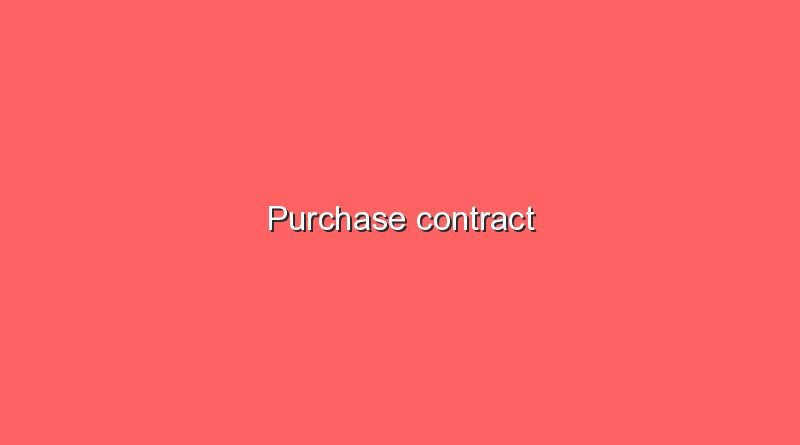Purchase contract

Various types of contracts play a role in business life. In addition to the work contract, service contract, work delivery contract and rental and lease contract, the purchase contract should be mentioned here.
conclusion of sales contracts
Every contract is formed by application and acceptance. The request can come from both the seller and the buyer.
partner in the contract of sale
There are two parties to the contract of sale: the buyer and the seller. Both may be merchants or non-merchants and the purpose of the purchase may be private or serve a commercial purpose. A distinction must be made between “civil purchase” and commercial purchase. Furthermore, the one-sided trade purchase and the two-sided trade purchase.
1. Citizen Purchase
The contracting parties are non-merchants. Or a merchant concludes a purchase contract for his private purposes. The legal basis for the “civil purchase” is the Civil Code.
2. Commercial Purchase
At least one contractual partner is a merchant and as such concludes a sales contract for his trade. The provisions of the Commercial Code apply here in the first place. If these are not sufficient, also those of the Civil Code.
a. Unilateral Commercial Purchase
Only one contractual partner is a merchant and concludes the purchase contract for business purposes. Example: Housewife buys groceries from Aldi.
b. Two-way trade purchase
Both contractual partners are merchants and buy for business purposes. An entrepreneur buys a van for his business from a car dealership.
There are a number of ways in which a contract of sale can be formed:
1. The seller makes an offer
The seller makes an offer, the buyer orders on time and without changes. This is how the contract of sale came about. If the buyer does not order in time or changes the offer, this is considered a new application. The purchase contract is then concluded by accepting the new application. Longer negotiations are necessary, especially in the case of significant purchases. This means that the purchase contract is legally effective when both parties have agreed on all points.
2. The seller makes a non-binding offer
The buyer’s order follows. The contract is concluded when the supplier confirms the order or delivers the goods.
3. The seller sends goods that have not been ordered
The unordered consignment of goods represents an offer. A purchase contract is only concluded when the buyer pays for the goods, uses them or declares that he accepts them.
4. The buyer orders (without prior offer), the seller accepts the order
The contract is concluded with the confirmation of the order or the immediate delivery of the goods.
5. The buyer orders, the seller does not accept the order
This can mean that the seller links a counter offer to the rejection. The purchase contract is only concluded when the buyer places a new order.
Obligations of the contracting parties in the purchase contract
The submission of an application and its acceptance are voluntary for both the buyer and the seller. The conclusion of the contract creates obligations for both parties. Therefore, the purchase contract is considered to be: a binding legal transaction.
Seller’s Obligations
The seller is obliged to hand over the goods free of defects and at the agreed time. In addition, he must provide the buyer with ownership of the item sold and accept the purchase price.
Buyer’s Obligations
The buyer must pay the agreed purchase price as contractually agreed and he must accept the goods.
The sales contract contains agreements on:
• The quantity of the goods
• Price of the goods
• Packaging
• Shipment
• Delivery time
• Terms of payment
• Place of fulfillment
• Transfer of Ownership
• Type of condition and quality of the goods
Quantity, type, quality and condition of the goods
The quantity can be in units of measurement: meters, square meters, grams, kilograms and others. Or in commercial terms such as dozen, piece, bale, box, truckload and others. The type of goods is identified by the commercial name. Condition and quality are features that can be determined by looking at samples and samples as well as illustrations and descriptions in catalogs or brochures.
shipment
The goods can be delivered personally, by messenger or with a transport vehicle. Collection by the buyer is also possible. When shipping, there are costs for delivery and supply, freight, weighing fees and loading costs. Who has to bear these costs is stated in the terms of delivery. For example:
• Ex works, ex stock
• Free house, free warehouse or free factory
• Postage paid, from here, from the station here
• Free wagon
• Free ship
If nothing is contractually agreed, the seller pays the costs of handover (measuring, weighing). The buyer bears the costs of acceptance and shipping (to a place other than the place of performance).
Visit the rest of the site for more useful and informative articles!




